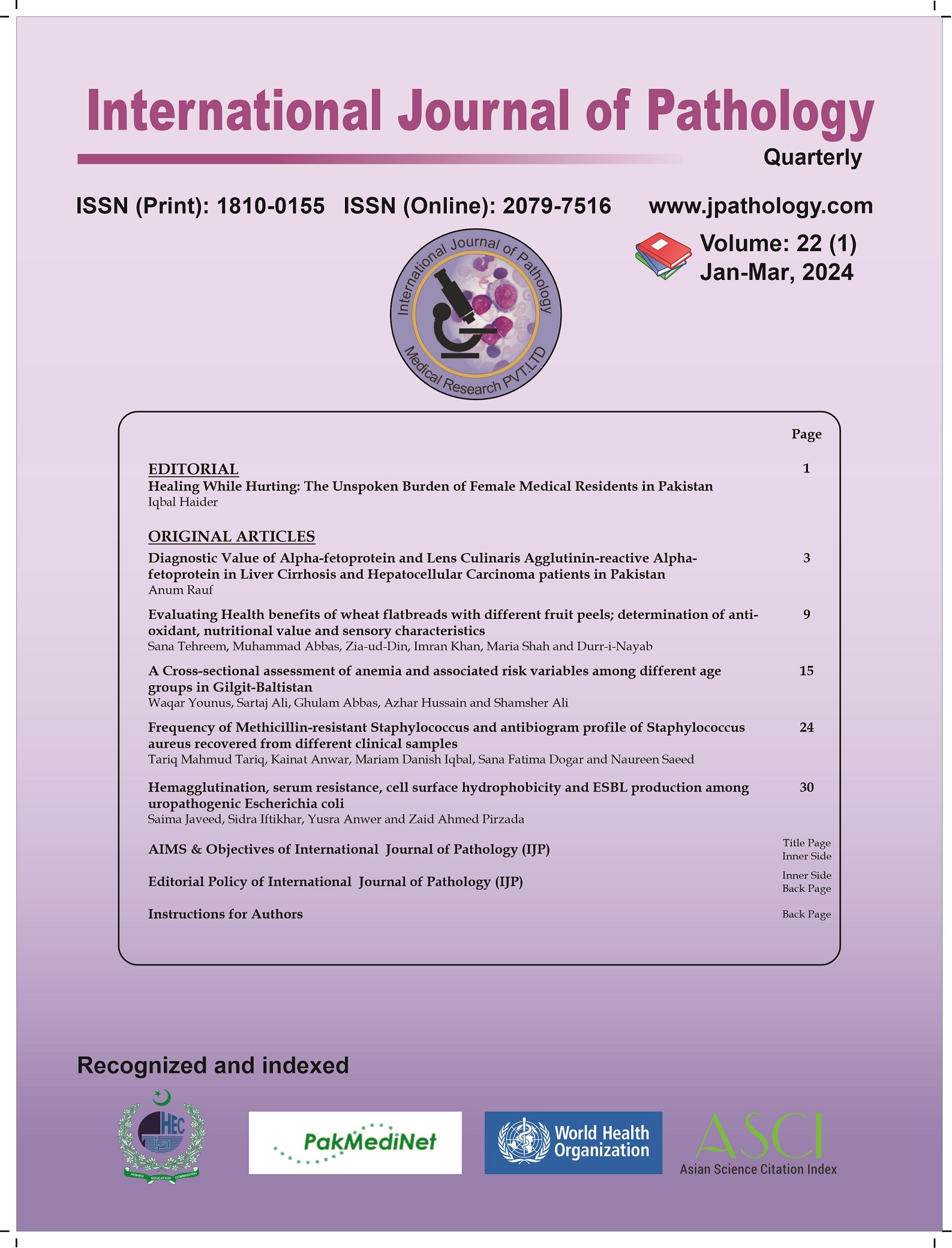Hemagglutination, serum resistance, cell surface hydrophobicity and ESBL production among uropathogenic Escherichia coli
DOI:
https://doi.org/10.59736/IJP.22.01.883Keywords:
Antibiotic Resistance, Drug Resistance, Escherichia Coli, Virulence Factors, Urinary Tract InfectionsAbstract
Background: Bacteria have adapted with increased pathogenesis and drug resistance mechanisms to overcome host defense systems. Uropathogenic E. coli (UPEC) responsible for symptomatic Urinary tract infections (UTIs) carry diverse virulence factors and extended-spectrum beta-lactamase (ESBL) production which play a pivotal role in pathogenesis and antibiotic resistance. This study aimed to determine the phenotypic expression of virulence factors; i.e., Hemagglutination, serum resistance, cell surface hydrophobicity, and resistance factor ESBL production among UPEC isolates.
Methods: In this prospective study 50 drug-resistant UPEC strains were evaluated for hemagglutination by slide method, cell surface hydrophobicity by salt aggregation test, serum resistance by serum bactericidal assay, and ESBL detection by double disc synergy test. Results: Among 50 UPEC strains 46 (92%) showed mannose-resistant hemagglutination, 48 (96%) were found to be serum resistant, 40 (80%) isolates were positive for cell surface hydrophobicity, while 43 (86%) were ESBL producers. Most of the UPEC that expressed virulence factors were ESBL producers as well.
Conclusion: Overall, this study indicated that drug resistant UPEC isolates have expressed several virulence factors with ESBL production. This explains how pathogens have increased their virulence and resistance repertoire resulting in treatment failures.
References
Ejrnæs K, Stegger M, Reisner A, Ferry S, Monsen T, Holm SE, et al. Characteristics of Escherichia coli causing persistence or relapse of urinary tract infections: phylogenetic groups, virulence factors and biofilm formation. Virulence. 2011 Nov 1; 2:528-37.
Samet M, Ghaemi E, Nejad MH, Jamali A. Prevalence of different virulence factors and biofilm production ability of urinary Escherichia coli isolates. Int J Biologic Med Res. 2014; 5:4546-9.
Reid G, Sobel JD. Bacterial adherence in the pathogenesis of urinary tract infection: a review. Rev. Infect. Dis. 1987; 9:470-87.
Lane MC, Alteri CJ, Smith SN, Mobley HL. Expression of flagella is coincident with uropathogenic Escherichia coli ascension to the upper urinary tract. Proceedings of the National Academy of Sciences. 2007 Oct 16; 104(42):16669-74.
Melican K, Sandoval RM, Kader A, Josefsson L, Tanner GA, Molitoris BA, et al. Uropathogenic Escherichia coli P and Type 1 fimbriae act in synergy in a living host to facilitate renal colonization leading to nephron obstruction. PLoS Pathog. 2011Feb 24; 7(2):e1001298.
Raksha R, Srinivasa H, Macaden RS. Occurrence and characterisation of uropathogenic Escherichia coli in urinary tract infections. Indian J Med Microbiol. 2003 Apr-Jun; 21(2):102-7. PMID: 17642991.
Ogawara H. Molecular phylogenetics of β-lactamases in Actinobacteria. Bull. Meiji Pharmaceut. Univ. 2013; 42:1-8.
Tabasi M, Karam MRA, Habibi M, Yekaninejad MS, Bouzari S. Phenotypic assays to determine virulence factors of Uropathogenic Escherichia coli (UPEC) isolates and their correlation with antibiotic resistance pattern. Osong public health Res Perspect. 2015; 6:261-8.
Von Elm E, Altman DG, Egger M, Pocock SJ, Gøtzsche PC, Vandenbroucke JP. The Strengthening the Reporting of Observational Studies in Epidemiology (STROBE) statement: guidelines for reporting observational studies. The lancet. 2007 Oct 20; 370(9596):1453-7.
Javed S, Mirani ZA, Pirzada ZA. Study of class 1 integrons and plasmid profile among multiple drug resistant uropathogenic Escherichia coli. Pakistan Journal of Pharmaceutical Sciences. 2020 Nov 1; 33(6).
Vagarali MA, Karadesai SG, Patil CS, Metgud SC, Mutnal MB. Hemagglutination and siderophore production as the urovirulence markers of Uropathogenic Escherichia coli. Indian Journal of Medical Microbiology. 2008 Jan 1;26(1):68-70.
Shruthi N. Phenotypic study of virulence factors in Escherichia coli isolated from antenatal cases, catheterized patients, and faecal flora. Journal of Clinical and Diagnostic Research: JCDR. 2012 Dec; 6(10):1699.
Benge G. Bactericidal activity of human serum against strains of Klebsiella from different sources. J. Med. Microbiol. 1988; 27:11-5.
Jarlier V, Nicolas M-H, Fournier G, Philippon A. Extended broad-spectrum β-lactamases conferring transferable resistance to newer β-lactam agents in Enterobacteriaceae: hospital prevalence and susceptibility patterns. Clin. Infect. Dis. 1988; 10:867-78.
Baby S, Karnaker VK, Geetha R. Determination of phenotypic expression of the fimbriae and hemolysin of uropathogenic Escherichia coli (UPEC). Int. J. Adv. Med. 2014; 1:13.
Kaira SS, Pai C. Study of uropathogenic Escherichia coli with special reference to its virulence factors. Int. J. Community Med. Public Health. 2017; 5:177-81.
Heilmann C. Adhesion mechanisms of staphylococci. Bacterial adhesion: Springer. 2011; 105-23.
Mittal S, Sharma M, Chaudhary U. Study of virulence factors of uropathogenic Escherichia coli and its antibiotic susceptibility pattern. Indian Journal of Pathology and Microbiology. 2014 Jan 1; 57(1):61-4.
Taylor PW. Bactericidal and bacteriolytic activity of serum against gram-negative bacteria. Microbiol. Rev. 1983; 47:46.
Qiao L-D, Chen S, Yang Y, Zhang K, Zheng B, Guo H-F, et al. Characteristics of urinary tract infection pathogens and their in vitro susceptibility to antimicrobial agents in China: data from a multicenter study. BMJ open. 2013; 3:e004152.
Iqbal R, Majid A, Alvi IA, Hayat A, Andaleeb F, Gul S, et al. Multiple drug resistance and ESBL production in bacterial urine culture isolates. Am. J. Bio Sci. 2014; 2:5-12.
Habeeb MA, Sarwar Y, Ali A, Salman M, Haque A. Rapid emergence of ESBL producers in E. coli causing urinary and wound infections in Pakistan. Pak. J. Med. Sci. 2013; 29:540.
Downloads
Published
Issue
Section
License
Copyright (c) 1970 saima javed, sidra iftikhar, yusra anwer, zaid ahmed pirzada

This work is licensed under a Creative Commons Attribution-NonCommercial 4.0 International License.
Readers may “Share-copy and redistribute the material in any medium or format” and “Adapt-remix, transform, and build upon the material”. The readers must give appropriate credit to the source of the material and indicate if changes were made to the material. Readers may not use the material for commercial purpose. The readers may not apply legal terms or technological measures that legally restrict others from doing anything the license permits.


